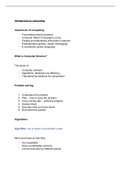Resumen
CSC1015F Summary notes of whole course
- Grado
- Institución
- Book
Summarized notes for the CSC1015F course at UCT. Notes are a summary of lectures, course material & textbook. I achieved a 90% for this course, with these notes. Detailed summary with examples, and explains everything you will need to know for any assignments/tests/exams.
[Mostrar más]




